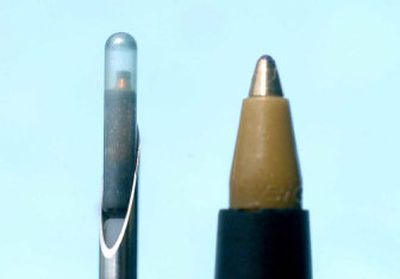Microchip your pet

Like energy-efficient cars, socialism and high tea, microchipping has never quite caught on here.
According to industry estimates, only 5 percent of American dogs and cats have been implanted with the rice-size transmitters, which can provide information to reunite an errant animal with its worried human. Thanks to politics and old-fashioned capitalism, that number probably won’t increase any time soon.
Microchipping made headlines last year, when Banfield, the veterinary hospital chain affiliated with PetSmart stores, began selling International Standards Organization, or ISO, chips.
Considered the universal standard in Europe – where 25 percent of companion animals are estimated to be chipped – and used for identifying livestock here, the ISO chip is not patented and so is cheaper than the 125 kHz chips used by the two American microchip companies, AVID and HomeAgain.
The AVID (formally known as American Veterinary Identification Devices) and HomeAgain chips (distributed by Schering-Plough) are encrypted and nonencrypted, respectively. AVID says encryption is an important security measure to ensure chip numbers can’t be duplicated.
AVID estimates there are 100,000 scanners in place nationwide at shelters and vet clinics. All can pick up the signals from AVID and HomeAgain chips, though some may be unable to decode the encrypted AVID chips.
But none can even detect the ISO chip, which brings us back to Banfield. The company did distribute some ISO-compatible scanners but not enough: In April 2004, a pit bull named Hadden was euthanaised by a Virginia shelter after a 125 kHz scanner failed to read his ISO chip.
One solution might be a scanner that can read all chips. But AVID – which sued Banfield for consumer fraud because there are so few scanners for reading the ISO chips – owns the patent for the chip-reading technology. And it doesn’t see a need to embrace the ISO’s higher 134.2 kHz frequency.
“AVID does sell ISO chips in those countries where they are the standard. But in this country, there is not a base of scanners that will detect them,” says AVID spokesman Dan Knox. “If we were going to change to another frequency, those 100,000 scanners have to be recalled, and it would cost $20 million to replace them.”
Others have a greater sense of urgency. Last year, several veterinary and animal-welfare groups – including the American Veterinary Medical Association and the American Society for the Prevention of Cruelty to Animals – formed the Coalition for Reuniting Pets and Families ( www.readallchips.com).
“The coalition’s purpose is not to push one chip or another – we don’t care who wins,” says veterinarian Daniel Aja of Traverse City, Mich., president of the American Animal Hospital Association. “All we want is a truly global scanner, one that will read every chip out there.”
Aja notes that AVID makes a scanner that will do just that. It is sold in Canada but not here. He also stresses that international incompatibility – encrypted AVID chips can’t be read abroad – is an issue in an increasingly global world, a concern Knox downplays.
“Most pets in America don’t go to France for the summer. They’re either going to get lost and found in a disaster or wandering three blocks down the road,” he says. “If someone’s going to another country, simply use another chip,” such as AVID’s nonencrypted Euro-Chip.
The scanner issue aside, Aja and his group also hope to consolidate the multiple chip databases into one national registry.